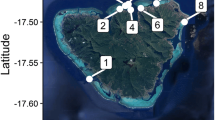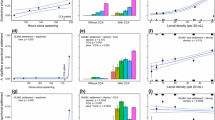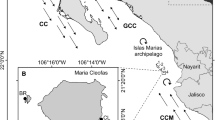Abstract
The spatial dispersion of the tropical coral sand-dwelling mesogastropod Strombus luhuanus Linné, 1758 was studied at several sites in two localities (Australian Great Barrier Reef and southern Papua New Guinea), from September 1980 to February 1983. S. luhuanus usually occurred in local aggregations, many of which were relatively dense with discrete boundaries: Four types of aggregation are described: mixed age-class, juvenile, mating, and clusters. The former two are termed colonies, because they persisted over time and exhibited some coordinated movements. Mixed age-class colonies contain individuals of all ages, but within them the different ageclasses are frequently spatially segregated from each other. This was sometimes due to the younger age-classes' preference for shallower areas, but also occurred in areas of constant depth. Juvenile colonies are relatively smaller in area but higher in density, and are dominated by a single size-class. Mating aggregations are concentrations of copulating individuals, in which competition between males for access to females occurs. Clusters are concentrations of inactive individuals (juvenile and adult) piled together in close contact. All types of aggregation were concentrated in only a part of what appeared to be the suitable habitat. Most aggregations' boundaries shifted over time within the habitat. We conclude that intraspecific attraction must be an important factor which maintains the spatial structure of all aggregations, although habitat specificity sets the larger area in which they move. Processes which may underlie this pattern, and some of its implications, are discussed.
Similar content being viewed by others
Literature cited
Abbott, R.: The genus Strombus in the Indo-Pacific. Indo-Pacif. Mollusca 1, 33–146 (1960)
Berg, C. J.: A comparative ethological study of strombid gastropods. Behaviour 41, 274–322 (1974)
Berg, C. J.: Behaviour and ecology of conch (superfamily Strombacea) on a deep subtidal algal plain. Bull. mar. Sci. 25, 307–317 (1975)
Bradshaw-Hawkins, V. I. and F. Sander: Notes on the reproductive biology and behaviour of the West Indian fighting conch Strombus pugilis Linnaeus in Barbados, with evidence of male guarding. Veliger 24, 159–164 (1981)
Croker, B. A. and E. B. Hatfield: Space partitioning and interactions in an intertidal sand-burrowing amphipod guild. Mar. Biol. 61, 79–88 (1980)
Frank, P. W.: Growth rates and longevity of some gastropod mollusks on the coral reef at Heron Island. Oecologia 2, 232–250 (1969)
Heip, C.: On the significance of aggregation in some benthic marine invertebrates. Proc. 9th Eur. mar. biol. Symp. 527–538 (1975). (Ed. by H. Barnes. Aberdeen: Aberdeen University Press)
Hesse, K. O.: Movement and migration of the queen conch Strombus gigas, in the Turks and Caicos Islands. Bull. mar. Sci. 29, 303–311 (1979)
Highsmith, R. C.: Induced settlement and metamorphosis of sand dollar (Dendraster excentricus) larvae in predator-free sites: adult sand dollar beds. Ecology 63, 329–337 (1982)
Johnson, I. M.: Papua New Guinea seagrasses and aspects of the biology and growth of Enhalus acoroides (L.S.) Royle. Aquat. Bot. 7, 197–208 (1979)
Poiner, I. R.: Microvariation in the fauna of a sublittoral sandbank, Moreton Bay, Queensland. Aust. J. Ecol. 2, 297–308 (1977)
Scheibling, R. E.: Abundance, spatial distribution, and size structure of populations of Oreaster reticulatus (Echinodermata: Asteroidea) on sand bottoms. Mar. Biol. 57, 107–119 (1980)
Smith, A. L.: Comparison of macrofaunal invertebrates in sand dollar (Dendraster excentricus) beds and in adjacent areas free of sand dollars. Mar. Biol. 65, 191–198 (1981)
Steele, W.: Changes in distribution and density of the gastropod, Strombus luhuanus in a subtropical seagrass habitat, 106 pp. B.Sc. Hons dissertation, Griffith University 1981
Whitlach, R. B. and S. Obrebski: Feeding selectivity and coexistence in two deposit-feeding gastropods. Mar. Biol. 58, 219–225 (1980)
Woodin, S. A.: Refuges, disturbance and community structure: a marine soft bottom example. Ecology 59, 274–284 (1978)
Author information
Authors and Affiliations
Additional information
Communicated by G. F. Humphrey, Sydney
Rights and permissions
About this article
Cite this article
Catterall, C.P., Poiner, I.R. Age-and sex-dependent patterns of aggregation in the tropical gastropod Strombus luhuanus . Mar. Biol. 77, 171–182 (1983). https://doi.org/10.1007/BF00396315
Accepted:
Issue Date:
DOI: https://doi.org/10.1007/BF00396315




